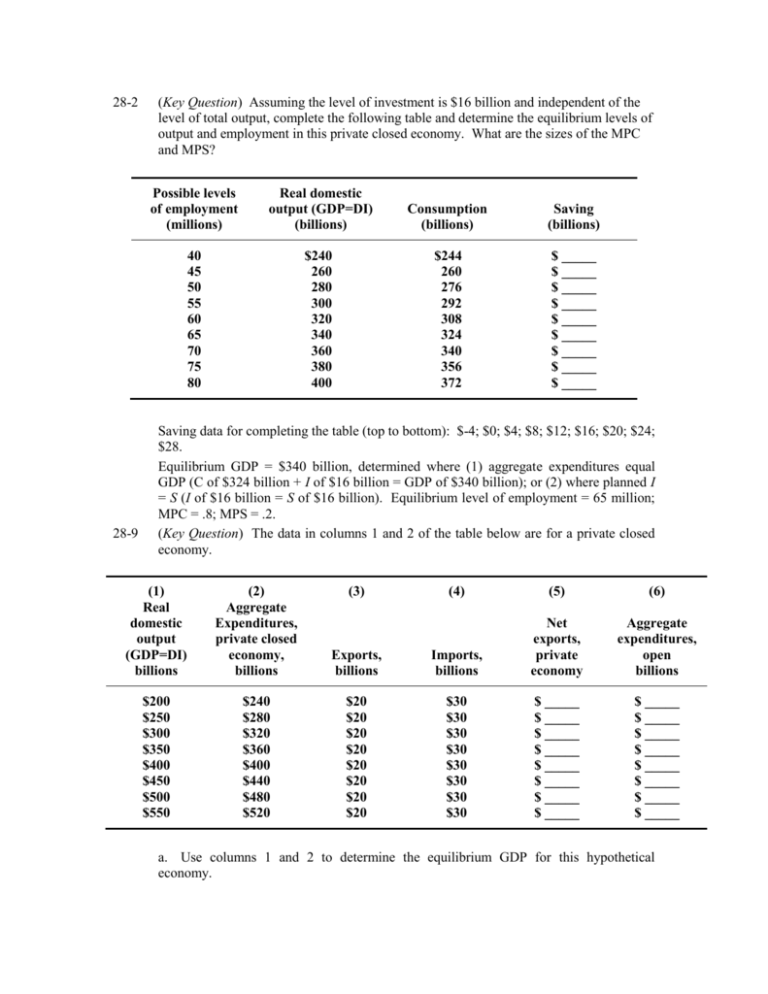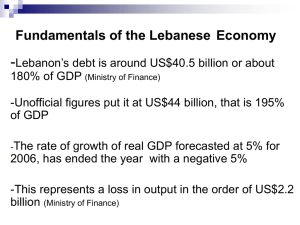Chapter 28 Key Question Solutions
advertisement

28-2 28-9 (Key Question) Assuming the level of investment is $16 billion and independent of the level of total output, complete the following table and determine the equilibrium levels of output and employment in this private closed economy. What are the sizes of the MPC and MPS? Possible levels of employment (millions) Real domestic output (GDP=DI) (billions) Consumption (billions) Saving (billions) 40 45 50 55 60 65 70 75 80 $240 260 280 300 320 340 360 380 400 $244 260 276 292 308 324 340 356 372 $ _____ $ _____ $ _____ $ _____ $ _____ $ _____ $ _____ $ _____ $ _____ Saving data for completing the table (top to bottom): $-4; $0; $4; $8; $12; $16; $20; $24; $28. Equilibrium GDP = $340 billion, determined where (1) aggregate expenditures equal GDP (C of $324 billion + I of $16 billion = GDP of $340 billion); or (2) where planned I = S (I of $16 billion = S of $16 billion). Equilibrium level of employment = 65 million; MPC = .8; MPS = .2. (Key Question) The data in columns 1 and 2 of the table below are for a private closed economy. (1) Real domestic output (GDP=DI) billions (2) Aggregate Expenditures, private closed economy, billions $200 $250 $300 $350 $400 $450 $500 $550 $240 $280 $320 $360 $400 $440 $480 $520 (3) (4) (5) (6) Exports, billions Imports, billions Net exports, private economy Aggregate expenditures, open billions $20 $20 $20 $20 $20 $20 $20 $20 $30 $30 $30 $30 $30 $30 $30 $30 $ _____ $ _____ $ _____ $ _____ $ _____ $ _____ $ _____ $ _____ $ _____ $ _____ $ _____ $ _____ $ _____ $ _____ $ _____ $ _____ a. Use columns 1 and 2 to determine the equilibrium GDP for this hypothetical economy. b. Now open up this economy to international trade by including the export and import figures of columns 3 and 4. Fill in columns 5 and 6 to determine the equilibrium GDP for the open economy. Explain why this equilibrium GDP differs from that of the closed economy. c. Given the original $20 billion level of exports, what would be the equilibrium GDP if imports were $10 billion greater at each level of GDP? d. What is the multiplier in this example? (a) Equilibrium GDP for closed economy = $400 billion. (b) Net export data for column 5 (top to bottom); $-10 billion in each space. Aggregate expenditure data for column 6 (top to bottom): $230; $270; $310; $350; $390; $430; $470; $510. Equilibrium GDP for the open economy is $350 billion, $50 billion below the $400 billion equilibrium GDP for the closed economy. The $-10 billion of net exports is a leakage that reduces equilibrium GDP by $50 billion. (c) Imports = $40 billion: Aggregate expenditures in the private open economy would fall by $10 billion at each GDP level and the new equilibrium GDP would be $300 billion. (d) Since every rise of $50 billion in GDP increases aggregate expenditures by $40 billion, the MPC is .8 and so the multiplier is 5. 28-12 (Key Question) Refer to columns 1 and 6 of the tabular data for question 9. Incorporate government into the table by assuming that it plans to tax and spend $20 billion at each possible level of GDP. Also assume that all taxes are personal taxes and that government spending does not induce a shift in the private aggregate expenditures schedule. Compute and explain the changes in equilibrium GDP caused by the addition of government. Before G is added, open private sector equilibrium will be at $350. The addition of government expenditures of G to our analysis raises the aggregate expenditures (C + Ig +Xn + G) schedule and increases the equilibrium level of GDP as would an increase in C, Ig, or Xn. Note that changes in government spending are subject to the multiplier effect. Government spending supplements private investment and export spending (Ig + X + G), increasing the equilibrium GDP to $450. The addition of $20 billion of government expenditures and $20 billion of personal taxes increases equilibrium GDP from $350 to $370 billion. The $20 billion increase in G raises equilibrium GDP by $100 billion (= $20 billion x the multiplier of 5); the $20 billion increase in T reduces consumption by $16 billion at every level. (= $20 billion x the MPC of .8). This $16 billion decline in turn reduces equilibrium GDP by $80 billion ($16 billion x multiplier of 5). The net change from including balanced government spending and taxes is $20 billion (= $100 billion - $80 billion). 28-13 (Key Question) Refer to the table below in answering the questions which follow: (1) Possible levels of employment, millions 90 100 110 120 130 (2) Real domestic output, billions $500 550 600 650 700 (3) Aggregate Expenditures (Ca+Ig+Xn+G), billions $520 560 600 640 680 a. If full employment in this economy is 130 million, will there be an inflationary expenditure gap or a recessionary expenditure gap? What will be the consequence of this gap? By how much would aggregate expenditures in column 3 have to change at each level of GDP to eliminate the inflationary expenditure gap or recessionary expenditure gap? Explain. What is the multiplier in this example? b. Will there be an inflationary expenditure gap or recessionary expenditure gap if the full-employment level of output is $500 billion? Explain the consequences. By how much would aggregate expenditures in column 3 have to change at each level of GDP to eliminate the gap? Explain. What is the multiplier in this example? c. Assuming that investment, net exports, and government expenditures do not change with changes in real GDP, what are the sizes of the MPC, the MPS, and the multiplier? (a) A recessionary gap. Equilibrium GDP is $600 billion, while full employment GDP is $700 billion. Employment will be 20 million less than at full employment. Aggregate expenditures would have to increase by $20 billion (= $700 billion -$680 billion) at each level of GDP to eliminate the recessionary gap. The MPC is .8, so the multiplier is 5. (b) An inflationary gap. Aggregate expenditures will be excessive, causing demand-pull inflation. Aggregate expenditures would have to fall by $20 billion (= $520 billion $500 billion) at each level of GDP to eliminate the inflationary gap. The multiplier is still 5 – the level of full employment GDP does not affect the multiplier. (c) MPC = .8 (= $40 billion/$50 billion); MPS = .2 (= 1 -.8); multiplier = 5 (= 1/.2).









